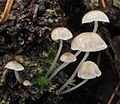pileipellis is more or less synonymous with the cuticle, but the cuticle generally describes this layer as a macroscopic feature, while pileipellis refers...
2 KB (266 words) - 06:35, 30 September 2021
distinctions, such as described in the article on the "pileipellis". Be that as it may, the pileipellis (or "peel") is distinct from the trama, the inner fleshy...
9 KB (957 words) - 16:25, 16 May 2024
absent, but some authors report inconspicuous "pseudocystidia". The pileipellis a cellular cuticle with subglobose elements and has pileocystidia. The...
7 KB (516 words) - 19:15, 15 May 2024
4–6 μm; they are smooth, elliptical, and inamyloid. Cystidia absent. Pileipellis without broom cells. Marasmius oreades is a choice edible mushroom. Its...
6 KB (645 words) - 16:11, 10 November 2023
(especially the pileus surface) as it loses or absorbs water, which causes the pileipellis to become more transparent when wet and opaque when dry. When identifying...
1 KB (110 words) - 01:52, 10 July 2019
(anatomy), the outermost layers of skin Cutis (mycology), a type of pileipellis in a fungus Cutis (journal), an academic journal of dermatology published...
395 bytes (76 words) - 02:22, 20 September 2018
taxonomically in the agaric family Strophariaceae based upon its spore and pileipellis morphology. The phylogenetic study by Matheny et al., placed the non-bluing...
36 KB (3,725 words) - 23:18, 22 May 2024
for morphologically separating the different species of the genus. The pileipellis is an ixocutis composed of parallel hyphae embedded in a gelatinous matrix...
12 KB (1,184 words) - 19:13, 18 May 2024
hyphae 5–32 μm, yellowish to yellowish brown, thick walled (0.5–1 μm). Pileipellis an ixocutis, (9–) 12–54 μm wide, hyphae 1.5–4 (–5.5) μm diameter, hyaline...
7 KB (645 words) - 01:24, 19 April 2024
germ pore. These agarics are also characterized by having a cutis-type pileipellis. Ecologically, all species in this group are saprotrophs, growing on...
5 KB (480 words) - 20:40, 14 October 2023
after Naohide Hiratsuka. It is characterized by a grey-purple then brown pileipellis and a reticulated stem near the hymenium. It is close to Boletus edulis...
4 KB (415 words) - 17:27, 30 April 2024
nonamyloid (that is, not absorbing iodine stain in Melzer's reagent). The pileipellis (cap cuticle) is composed of filamentous interwoven hyphae, 2–7 μm diameter...
9 KB (911 words) - 03:59, 18 April 2024
Bolbitius is defined as small thin Mycena-like mushrooms, with a hymenoderm pileipellis, a glutinous cap surface, and spores that are brown in deposit. Spores...
3 KB (211 words) - 02:21, 23 May 2024
covered in fine, downy scales. This layer on the cap is known as the pileipellis, which is either classified as a trichoderm—parallel hyphae running perpendicular...
29 KB (2,907 words) - 23:46, 30 April 2024
amethystina spores) and long spines characteristic of L. amethystina. The pileipellis of L. vinaceobrunnea is unique within Laccaria, having a distinct palisadoderm...
13 KB (1,344 words) - 19:20, 15 May 2024
gills attached to a long and slender cartilaginous stem. Species have a pileipellis that is a cutis, and ornamented spores that are brown in deposit, where...
16 KB (1,660 words) - 22:50, 8 March 2024
lack of cheilocystidia, and the lack of a dryophila-structure in the pileipellis. The fungus grows on fallen leaves or humus. List of Gymnopus species...
3 KB (193 words) - 21:39, 14 May 2024
or cuticula, a waxy polymeric film covering all aerial plant surfaces Pileipellis or cuticle, the uppermost protective layer of a fungal fruit body This...
776 bytes (149 words) - 21:39, 10 April 2019
Caps with a basal tomentum. Odor not distinctive. Clamps present in the pileipellis and the lamellar trama. Cheilocystidia is hyaline and capitate. Basidia...
2 KB (141 words) - 07:29, 10 May 2024
thick-walled, brown, smooth, and have a germ pore. The cap surface (pileipellis) is neither gelatinized nor cellular. Clamp connections are present in...
3 KB (201 words) - 00:37, 11 March 2024
are thick-walled, brown, smooth, and lack germ pore. The cap surface (pileipellis) is somewhat cellular with irregular puzzle-like to pyriform hyphae....
2 KB (185 words) - 23:36, 10 March 2024
tissues, poorly to moderately differentiated cheilocystidia, diverticulate pileipellis hyphae and general smooth stipe hyphae with scattered caulocystidia....
5 KB (317 words) - 01:48, 28 April 2023
filamentous cap cuticle (pileipellis) and thick-walled pleurocystidia. Section Hispidoderma consists of species with a filamentous pileipellis and thin-walled...
79 KB (3,069 words) - 17:11, 21 January 2024
fruit body. It is distinct from the outer layer of tissue, known as the pileipellis or cuticle, and from the spore-bearing tissue layer known as the hymenium...
2 KB (323 words) - 22:25, 24 October 2022
spheropedunculate, hyaline or brown, thin-walled, forming a sterile band. Pileipellis a cutis with cylindrical terminal elements, occasionally narrowing at...
4 KB (400 words) - 15:46, 26 January 2024
Cheilocystidia are rare to absent and pleurocystidia are absent. The pileipellis is a cutis and clamp connections are present. Species in Pseudotricholoma...
2 KB (152 words) - 23:40, 15 May 2024
Folsomia candida. Suillus luteus is an edible mushroom, but the slime/pileipellis must be removed. Although some authors regard it as one of low quality...
48 KB (4,960 words) - 04:31, 10 January 2024
the size and ornamentation of the spores, and the structure of the pileipellis. Furthermore these characters may be very variable and overlap between...
18 KB (1,766 words) - 08:32, 16 May 2024
species that have a hymenium on gills, brown spores and a hymenoderm pileipellis. Bolbitius are mushrooms which are thin, Mycena-like, with gelatinous...
4 KB (304 words) - 22:43, 23 March 2024
and have thin walls and various forms. Pleurocystidia are absent. The pileipellis is a cutis and clamp connections are present. Species in Corneriella...
3 KB (234 words) - 17:37, 3 January 2024





















